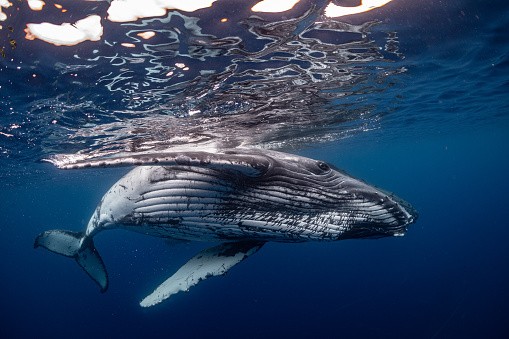Underwater, humpback whales are a dominating species capable of attacking much smaller sharks. However, in a turn of events, a marine biologist witnessed the drowning of a 33-foot humpback whale after being attacked by a great white shark.

The behemoth sea creature was seen off the coast of South Africa, where a 13-foot great white shark was circling the whale who seemed ill. Ryan Johnson, the marine biologist who captured the rare event on his drone, said that the attack lasted less than an hour before the whale drowned to its death.
Mr. Johnson recognized the shark to be Helen, which was tagged in one of his earlier studies in 2013. Ryan described how strategic the shark had been about the entire attack. 'The shark was very strategic about it, there was no hesitation, it was as if she knew exactly how to go about it,' said Ryan.
'The first strike was at the whale's tail, the skinny part above the flukes where she could get her mouth all the way around. She managed to open a vein and blood immediately started pluming out.' The fatal cut in the tail caused the whale to bleed out slowly for about 30 minutes before Helen continued her attack.
The second attack was aimed towards the humpback whale's head. The attacker latched on her victim and attempted to drown the giant sea creature.
Humpback Whale Drowning
Keeping the whale's blowhole underwater, Helen managed to finally drown it. Ryan said that the whale was not able to resurface after drowning.
'Helen looked very informed about what she was doing, which made me curious about whether she was an experienced whale killer, was acting on instinct or on plain intelligence by detecting her prey was weak,' observed Ryan.
While observing the whale, Ryan observed that it had mottled skin, or patches of red and purple skin, as the whale became separated from its pod or group of whales. Both were indicators of poor health which left it vulnerable to an attacker such as Helen.
This is the first time that an adult humpback whale had been attacked and killed by a great white shark. Usually, whales are able to ward off sharks using their powerful tails and killer whales tend to kill smaller shark species too.
Read Also: Japan Resumes Whale Hunting After 31-Year Ban
Shark Vs. Whale
A similar occurrence was reported in January when a crew from the Oceans Research Institute's research vessel rescued a 23-foot humpback whale entangled in a fishing net. The sick whale was malnourished and covered in whale lice and barnacles, or tiny crustaceans.
The humpback, in its condition, was attacked by two great white sharks. They had attacked its left flank and then its head, similar to what Helen had done. After an hour and a half, the animal died after the third attack to its tail.
The authors noted, 'We acknowledge that this was a singular event, a consequence of the whale being entangled and in poor condition. Therefore, the event should not reflect all white shark attacks on live baleen whales. Nevertheless, this paper presents observations on a rarely observed interaction between white sharks and live whales.'
Furthermore, South African waters rarely have great white sharks. It is believed that Port and Starboard, both killer whales, have dominated the area and kept sharks away. Ryan's footage will be part of the documentary Shark vs. Whale to be released on National Geographic Wild on July 28.
Read Also: How Modern Whales Swim is Linked to the Skeleton of Extinct Dolphin
© 2025 ScienceTimes.com All rights reserved. Do not reproduce without permission. The window to the world of Science Times.











